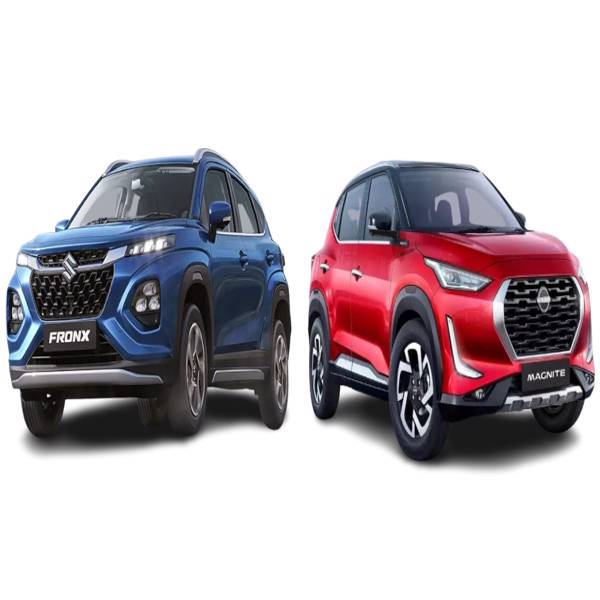In the Realm of Compact SUVs: Fronx AMT vs Magnite AMT
In the market for a small city SUV with an automatic transmission for under 10 lakh rupees? The Maruti Suzuki Fronx AMT and Nissan Magnite AMT are strong contenders. But which one reigns supreme? Let’s break it down to help you decide.
These two SUVs offer distinct design philosophies. The Fronx, with its roots in the Baleno hatchback, boasts a sleeker profile. While plastic cladding adds a touch of toughness, it doesn’t quite scream “SUV.” In contrast, the Magnite embraces a bolder stance. Its taller and square build projects a more commanding presence.
Dimensionally, they’re nearly neck and neck. The Fronx edges out the Magnite in length, width, and wheelbase. However, the Magnite takes the crown for height and ground clearance (205mm vs 190mm). Both come with LED headlights, but the Fronx only offers 16-inch alloy wheels on the Delta+ trim, not the top-of-the-line Alpha.
Feels more like a dressed-up hatchback than a rugged SUV. The cabin isn’t particularly spacious, and the lack of driver’s seat height adjustment limits driving comfort. However, the modern dashboard with multiple textures elevates the interior, and the material quality is good.
Magnite: Embraces the SUV persona with a roomier feel. The wider dashboard layout and higher seating position create a sense of spaciousness. While the plastics and overall quality are decent, they don’t match the Fronx’s refinement.
The Magnite takes the storage crown. It offers proper bottle holders in the center console, a dedicated center armrest for the driver, and better overall cubby space. The Fronx offers limited storage with a tiny area under the climate control and small cup holders.
Seating:
- Fronx: Wins on comfort with large, soft, and supportive seats. However, headroom is a concern for taller passengers due to the sloping roofline. The legroom and knee room are good, but the rear seat is cramped for three adults. It offers the middle passenger a headrest and three-point seatbelt, but comfort suffers. Boot space is 308 liters.
- Magnite: Seats are slimmer and less cushioned than the Fronx. However, the driver’s seat height adjustment helps with comfort. The rear space shines with impressive legroom, a flat floor for the center passenger, and rear AC vents (missing in the Fronx). The lack of a central headrest and only a lap belt for the middle passenger is a safety concern. Boot space is slightly larger at 336 liters.
- 360-degree camera for tight spots, keyless entry and go for a smoother experience.
- Entertainment: A larger 8-inch touchscreen compared to the Fronx’s 7-inch unit, and a 6-speaker sound system for better audio quality.
Safety:
- Magnite: Dual airbags, TPMS (Tire Pressure Monitoring System), and a 4-star adult occupant safety rating in Global NCAP crash tests (old regime).
- Fronx: Dual airbags, but not yet tested by Global NCAP.
Fronx vs Magnite: Powertrain Punch
Performance: Fronx knocks it out of the park.
- Engine: Packs a more powerful punch with a 1.2L, 4-cylinder engine generating 90hp, compared to the Magnite’s 1.0L, 3-cylinder engine at 72hp.
- Acceleration: Fronx zooms from 0-100 kph in a much faster 13.70 seconds, leaving the Magnite in the dust at 20.71 seconds.
- Transmission: Fronx’s AMT is smoother and more refined in gear changes compared to the Magnite.
Overall: While the Magnite offers some convenience and infotainment features, the Fronx delivers superior performance, and a potentially smoother ride, and might be a safer choice considering the missing NCAP rating for the Magnite.
Both handle rough roads well, but the Fronx takes the crown with a slightly softer and more supple ride. The Magnite leans towards a firmer feel.
Handling: The Fronx’s lower center of gravity due to its shorter height translates to flatter handling around corners, minimizing body roll. The Magnite’s taller stature leads to a bit more body leanness during maneuvers.
Steering: Both SUVs offer light and maneuverable steering, making city driving a breeze. However, the steering wheel tilt adjustment is the only option, lacking reach adjustment.
The Verdict: Fronx or Magnite?
This is a close call, with each SUV boasting distinct strengths.
Magnite’s Advantages:
- Practicality: More space for passengers and cargo, taller stance with higher ground clearance.
- Features: Packed with features like a 360-degree camera, keyless entry, and a larger touchscreen, all at a potentially lower price point.
- Safety: Rated 4 stars for adult occupant safety in Global NCAP crash tests (old regime).
front’s Advantages:
- Performance: Packs a more powerful engine and a smoother, more refined AMT gearbox, translating to a more enjoyable driving experience.
- Handling: Offers flatter and more composed handling due to its lower center of gravity.
- Ride Comfort: Delivers a slightly softer and more comfortable ride on uneven surfaces.
The Fronx Edges Out:
While the Magnite offers a compelling feature package and practicality, its sluggish engine and clunky AMT are significant drawbacks. The Fronx, on the other hand, provides a more enjoyable driving experience with its proven powertrain and refined AMT. Even though the Delta+ trim might not have all the bells and whistles of the Magnite, it covers the essentials.
Also read : Tata Altroz Racer VS Hyundai i20 N line
In conclusion, although the Magnite appears feature-rich on paper, the Fronx’s well-rounded performance, potentially smoother ride, and potentially better safety rating (due to missing NCAP data for the Magnite) make it our recommendation.



